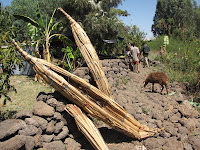Our guide book said that there were no ATMs that accepted foreign credit cards but we were told that there were now several ATMs. One of the problems we had getting money was that the machines were in strange places like the Hilton and Sheraton hotels. Some only dispensed about $20 NZ as the maximum you could get out at one time so it took a bit of trial and error before we found machines that would give us larger amounts in one transaction, as we must pay a fee each time we get money out.
Before heading for Bahir Dar we met a Canadian guy who was heading in the same northerly direction and he had only a short time so decided to fly between the historic sites. We checked out Ethiopian Airways and found we could save four 12 hour days travel on crowded , hot, and dusty buses if we also flew. As we flew in with their airline we got a good discount to fly internally, so before leaving Addis we organised our flights to return from the north.
We caught a 5am Skybus in the main square from Addis to Bahir Dar. It was very modern with a TV showing movies and music CDs. We were given a slice of cake, juice, and a bottle of water for breakfast, all included in our ticket price. I think a taxi driver told us about the bus company otherwise we would have had to take a cramped minivan at 3am. I think whoever refers you to the minivan gets a commission, so it is always suggested as the only option for travelling outside the city.
The bus stopped at a local village restaurant for lunch and toilet stop. The toilets were disgusting and even the local women screwed up their noses at the smell and sight of them. The country deperately needs decent plumbers! Of course the men don't care as they go wher ever they are and whenever they want!
We passed through some spectacular mountain passes and this spot was another toilet stop with no facilities.
In the flat farmlands the locals were harvesting 'tef', the local grain that is used to make the traditional ingera pancakes. We saw men and women using short handled sickles to cut the stalks.
In the fields were circular working areas where the men chased bullocks tied together around and around over the tef grains to crush them. After this they forked the stalks into the air for the wind to blow the husks and debris away in the wind. The stalks were then piled up in stacks to dry. We saw some donkeys loaded with stalks taking them to feed the animals. Outside the mud and daub houses the women could be seen drying the tef or pounding it into flour. It all reminded us of our social studies lessons in our primary school days. They have been doing it this way for centuries.
Bahir Dar is on the shores of Lake Tana and its 'mystical monasteries' according to our guide book. We managed to get a clean and basic hotel and headed off to check out the lake. Dozens of locals were sitting on the shore looking at the lake that looked dirty with lots of green algae. We found a boatman who would take us and Andy, an Australian guy we met, for a trip to see the monasteries.
The monasteries date from the 16th and 17th centuries and some were built on pre-Christian sites. One is supposed to contain the Ark of the Covenant and other than the priests no one can see them or they will go blind.
This old book was in the museum and printed on goat vellum.
Inside the monastery were vividly painted religious scenes.
The outside of the monastery, Ura Kidan Mehret.
We saw several reed9 papyrus ) boats loaded with wood from the islands that they were taking to Bahir Dar to sell or convert to charcoal. The smaller boats were used for fishing.
There are about 20 islands with monasteries and there were many Ethiopian pilgrims visiting some of the sites at the same time as us. Christianity came to Ethiopia in the 4th century. 45% of the people are Christian and 35% are Muslim.
The boat trip was supposed to cover 5 monasteries but the one that could only be visited by men was closed so John and Andy couldn't see it. One of the others was under construction and not worth seeing. The 5th one was nothing like the first one and was a disappointment as it had coloured posters stuck to the monastery walls. However it was quite nice to be on the boat and
see the hippos by the source of the Nile outflow.
see the hippos by the source of the Nile outflow.
John also got to drive the boat.








